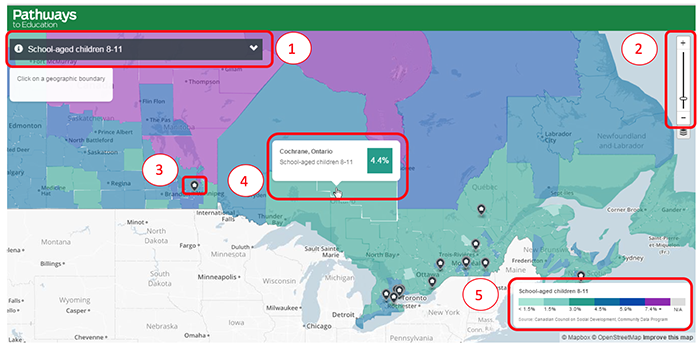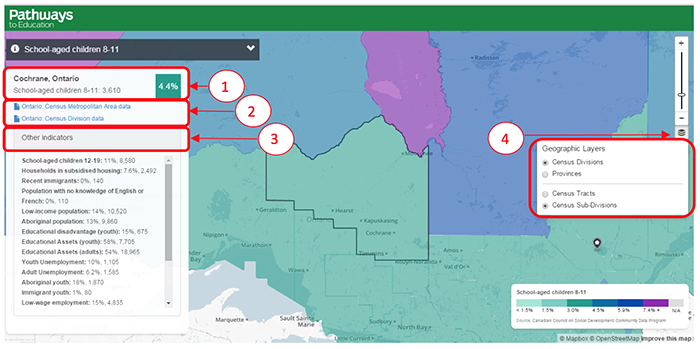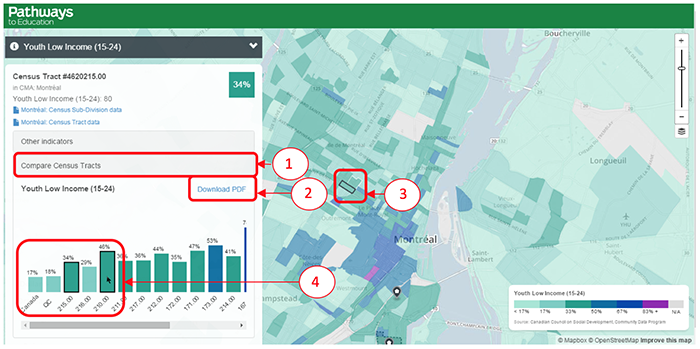Community Mapping Tool
Insights for Successful Youth and Strong Communities
What is the Community Mapping Tool?
Pathways to Education Canada has partnered with the Canadian Council on Social Development (CCSD) to develop the Community Mapping Tool, a resource to help understand the barriers youth face in their communities as a result of poverty. The publically-available tool allows users to compare communities and identifies key indicators that make up the tremendous diversity of Canada.
Community-level data on the tool is resourced by current census data from Statistics Canada. Information will be updated every five years with the release of the new census.
- Students and researchers can use the tool for research projects and to look at patterns across cities, regions, and provinces/territories.
- Educators can use the tool to create engaging instructional material and course curriculum.
- Community advocates can design visually engaging community campaigns and support ongoing community engagement around issues of local importance.
- Funders can track important community-wide trends to help set priorities and contribute to meaningful program development and evaluation.
- All users will be able to create compelling narratives about their communities and the critical role of learning and education for young people.
What are the Indicators?
The following indicators were added to the Community Mapping Tool because they help to identify the barriers that youth in low-income communities face.
Children and Youth by Age
- Children, aged 8 to 11 (number, per cent of total population)
- Youth, aged 12 to 19 (number, per cent of total population)
Family
- Single-Parent Families (number; per cent of all families)
Ethno-Cultural Make-Up
- Indigenous Population (number; per cent of total population)
- Indigenous Population, aged 15 to 24 (number; per cent of population, aged 15 to 24)
- Recent Immigrants (number; per cent of total population)
- Immigrant Population, Aged 15 to 24 (number; per cent of population, aged 15 to 24)
- Visible Minority Population (number; per cent of total population)
- Population with no knowledge of Official Languages, English or French (number; per cent of total population)
Income and Employment
- Average After-Tax Income for Population Aged 25+
- Low Income Population (LIM-AT, Low Income Measure-After Tax) (number; per cent of total population)
- Youth Low Income Population Aged 15 to 24 (number; per cent of population aged 15 to 24)
- Modest Income Population (number; per cent of total population)
- Households in Subsidized Housing (number; per cent of all households)
- Population 20 to 34 that is Unemployed (number; per cent of labour force aged 20 to 34)
- Population 35 to 64 that is Unemployed (number; per cent of labour force aged 35 to 64)
- Population 25+ Working in Retail, Accommodation, and Food Services (number; per cent of employed workers aged 25+)
Educational Attainment
- Population 20 to 24 with no Educational Diploma or Certificate (number; per cent of population aged 20 to 24)
- Population 20 to 34 with Post-Secondary Educational Degree or Certificate (number; per cent of population aged 20 to 34)
- Population 35 to 64 with Post-Secondary Educational Degree or Certificate (number; per cent of population aged 35 to 64)
All of these indicators are made visible to users across four different levels of geography:
- Census Division (CD) is a group of neighbouring municipalities joined together for the purposes of regional planning and managing common services (e.g., a county, a regional municipality, a regional district).
- Census Metropolitan Area (CMA) and Census Agglomeration (CA) are areas consisting of one or more neighboring municipalities situated around a major urban core. A CMA must have a total population of at least 100,000, of which 50,000 or more live in the urban core. A CA must have an urban core population of at least 10,000.
- Census Subdivision (CSD) is typically a municipality but may also be an area deemed to be equivalent to a municipality for statistical reporting purposes.
Census Tract (CT) is a geographic area with a population of 2,500 to 8,000. They are located in census metropolitan areas and in census agglomerations with an urban core population of 50,000 or more in the previous census.
Important Definitions
Low income has been measured using the Low Income Measure based on After-Tax Income. The Low income measure after tax (LIM-AT) is a fixed percentage (50%) of median adjusted after-tax income of households observed at the person level, where ‘adjusted’ indicates that a household’s needs are taken into account.
Modest Income We define modest income as the percentage of the total population with household income greater than the Low Income Measure (measured after tax), but below the 30th income percentile.
Density of Low Wage Employment: Another important risk factor in disadvantaged neighbourhoods is the quality of available employment. Neighbourhoods where workers rely disproportionately on employment in sectors like retail trade are more likely to experience low incomes. For the mapping tool, we include the proportion of all employed workers aged 25 years and older working in retail and accommodation and food services. These industries have the lowest hourly and weekly wage and their incidence was correlated with the rate of low income.
Subsidized Housing: Subsidized housing refers to dwellings that are subsidized, including rent geared to income housing, social housing, public housing, government-assisted housing, non-profit housing, rent supplements, and housing allowances.
Visible Minority: Statistics Canada uses the definition of visible minorities included in the Employment Equity Act. The Employment Equity Act defines visible minorities as ‘persons, other than Aboriginal peoples, who are non-Caucasian in race or non-white in colour.’ The visible minority population consists mainly of the following groups: South Asian, Chinese, Black, Filipino, Latin American, Arab, Southeast Asian, West Asian, Korean, and Japanese.
Aboriginal Population: The mapping tool reports on those who identify themselves as Aboriginal people, that is, as First Nations (North American Indian), Métis, or Inuk (Inuit). It also includes those who report being a Registered or Treaty Indian (that is, registered under the Indian Act of Canada) and/or being a member of a First Nation or Indian band.
New Immigrant: New Immigrants are defined as those who immigrated to Canada between 2006 and 2011, the year of the last Census.
Using the Mapping Tool
Pathways’ Community Mapping Tool is an easy-to-use web mapping application that lets you view different kinds of information about communities across Canada. You can view individual indicators, such as the population of children aged 12 to 19, on your map, and compare your selected community against others. This tutorial will guide you through the steps needed to do these things.
For more information about the indicators and sources of information used to build this mapping tool, please see: More Info
Opening Screen

- The indicator drop-down list allows the user to change the indicator being displayed on the map. A definition for each indicator is available by clicking the
 to the left of the indicator.
to the left of the indicator. - The zoom-slider changes the scale of the map. The geographic layers displayed at wide zoom levels (Census Divisions, Provinces) are different than the layers displayed at narrow zoom levels (Census Tracts, Census Subdivisions). See below for details on changing the geographic layer and More Info for definitions of the geographies used in the Mapping Tool.
 This icon indicates the location of a Pathways Program host organization. Catchment areas for these organizations are indicated on the map with a dashed line.
This icon indicates the location of a Pathways Program host organization. Catchment areas for these organizations are indicated on the map with a dashed line.- Hovering the mouse pointer over an area of interest will display the value for the selected indicator.
- The colour-coded legend displays indicator value ranges. This legend changes depending on the indicator selected.
Moving through the Map

- Clicking on the map will zoom into the geographic region of interest and display the area’s name and indicator values. Both the count and percentage values are displayed.
- Indicator data can be downloaded in CSV format. The geographic level of the available data will vary with the geographic layer selected (see #4).
- Additional indicator values can be displayed by clicking on ‘Other indicators’.
- At wide zoom levels, the user can select between displaying Census Division data or Provincial data. At narrow zoom levels, the user can select between displaying Census Tract or Census Subdivision data.
Comparing Census Tracts

- Upon selecting a Census Tract, the Census Tract’s numeric identifier will appear and the Compare Census Tracts option will be made available. This option generates a chart comparing the Census Tract of interest to the Canadian and provincial averages as well as the closest 15 Census Tracts.
- The chart can be downloaded in PDF format.
- The selected Census Tract will be highlighted in black.
- Moving the mouse pointer over the chart will highlight a comparison Census Tract in white (see 3 above). Clicking on a Census Tract result in the chart will re-focus the map to that Census Tract.
How do you cite the Community Mapping Tool?
If you are citing the Map itself, please cite:
Pathways to Education Community Mapping Tool. (2016). Name of region, Province, Geography level, Retrieved date, from https://communitymappingtool.pathwaystoeducation.ca/
Contact
For more information about the Pathways to Education Community Mapping Tool, please contact:
Tanya Sethi
Director, Research & Evaluation, Pathways to Education Canada
tsethi@pathwayscanada.ca or (416)-646-0123 ext. 212
